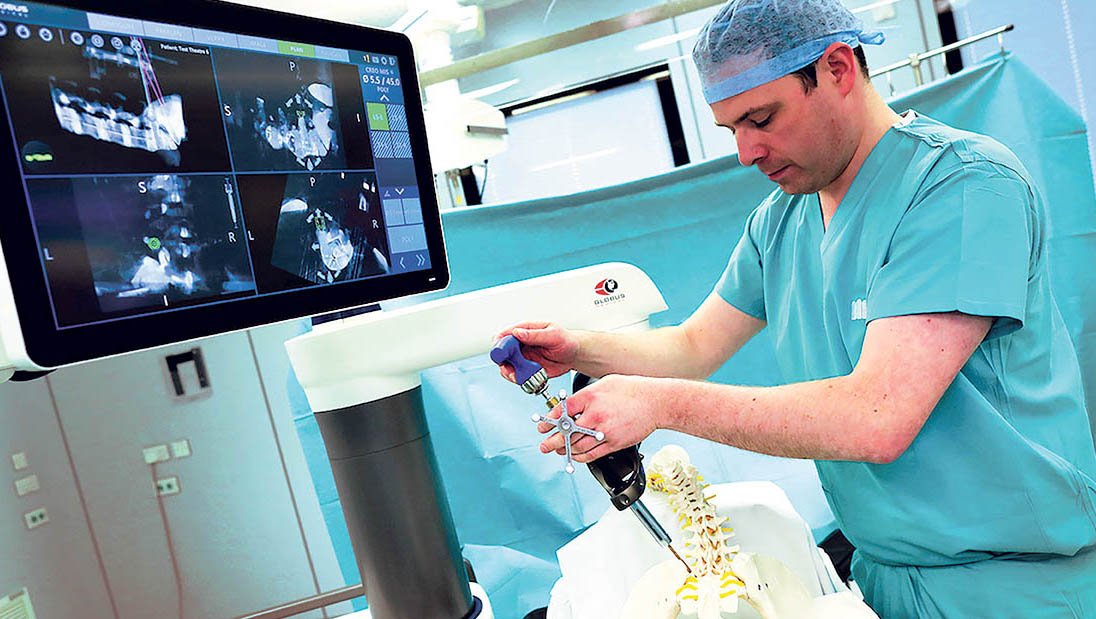Dr Tiarnán Ó Doinn, Research Fellow, DCU; Dr Daniel Ahern, Surgical/Orthopaedic Trainee and Research Fellow, UCC; and Mr Joseph Butler, Orthopaedic Consultant Surgeon, Mater Private Hospital, write about developments in the use of robotic-assistance for spinal surgery
Spinal surgery has undergone considerable technological advances over the past number of decades, the most recent of which include the use of image-guided navigation systems and robotic-assisted surgery. Robotic assistance confers numerous advantages including the potential to mitigate fatigue and may offer superior precision of fine movement, irrespective of the length of the surgical procedure. These attributes are particularly well-suited to spinal surgery, where procedures are often lengthy, physically demanding and require delicate fine motor control throughout. Additionally, the radiopaque and rigid properties of the adult axial skeleton facilitates the utilisation of image guided navigation and robotic assistance for the placement of spinal instrumentation, such as rods and screws. In an Irish context, we have been quick to adapt these new approaches to spinal surgery, with the Mater Private being one of few European hospitals to offer robotic-assisted spinal fusion surgery, and the first in both Britain and Ireland.
Navigation systems
Navigation systems in their simplest form determine an instrument’s location in space and its relation to its surroundings. Modern surgical navigation systems use a stereoscopic camera to determine the location of reference markers attached to both the patient and surgical instruments. This allows tracking of the relationship between instruments and the patient which is relayed to a monitor in the operating theatre, providing real-time feedback.
In spinal surgery these technologies were initially implemented in the placement of pedicle screws. Accurate placement of pedicle screws is essential to achieving a solid purchase for any spinal construct, while also circumventing damage to structures in close proximity to the spinal column. Numerous meta-analyses and systematic reviews have examined the safety and accuracy of navigation assisted pedicle screw placement versus free hand placement. Overall, current evidence demonstrates increased accuracy of screw placement with image-guided navigation systems. However, one critical factor which has limited the accuracy of these navigation systems has been the opportunity for human error. This has been resolved with the recent advent of robotic-assisted technologies. These technologies use the same navigation systems but have the advantage of avoiding surgeon interference with the tracking systems, while also decreasing the risk of human error through fatigue.
Robotic-assisted surgery
Robotic assistance can be grouped into three broad categories based on the level of input by the surgeon. Firstly, there are telesurgical systems which consist of remote command stations in which the robot mirrors the surgeon’s movements. Secondly, there is the ‘shared- control’ model where the surgeon and the robot control instrument movements. Finally, there are supervised controlled systems which involve a robot performing autonomous movements under close supervision by the surgeon. Numerous companies have designed robots in each of these three categories.
SpineAssist/Renaissance/Mazor X (Mazor Robotics): Mazor robotics are the pioneers of robotic-assisted spinal surgery, with their products being among the earliest to be used in practice. As a result, their products have been the most studied in the field of robotic-assisted spinal surgery. Their system uses a ‘shared-control’ model while operating, with pedicle drilling being performed by the surgeon. Preoperative and intraoperative surgical planning using the robotic-assisted navigation system produces a template for screw entry point, trajectory and size. The robot can be either fixed to the patient at the spinal process during open procedures or with a frame triangulated with K wires for minimally invasive spinal surgery. Finally, a verification procedure is then used using tracked K-wires in the mounted robot and the virtual template, enhancing the accuracy of the procedure. This system has been shown to be accurate to within 1 mm of preoperative templates during pedicle screw insertion in cadaveric models, while also having superior accuracy versus fluoroscopically guided screw insertion.
ROSA: The Rosa robot, by Zimmer Biomet is a system which has been suggested to be best suited to minimally invasive spinal (MIS) surgery and percutaneous procedures due to enhanced fixation strength of the robotic arm to the patient. The ROSA robot is a free-standing device, comprised of a rigid robotic arm and a floor- fixable base. The robotic arm and the patient move synergistically using tracking camera monitoring and percutaneously placed pins. Lonjon et al demonstrated the enhanced accuracy of this system in the insertion of robotic-assisted pedicle screws (97.3 per cent) versus freehand insertion (92 per cent).
da Vinci Surgical System
The da Vinci Surgical System by Intuitive consists of two units: A surgical console and a robotic arm. The console equips the surgeon with 3D vision screens and portals to manipulate surgical instruments. This robot has gained widespread use in multiple surgical specialities including general surgery, urology and gynaecology. It offers the advantage of limitless range of motion, tremor filtering and high definition stereoscopic vision. In spinal surgery, this system has been applied to laprascopic anterior lumbar interbody fusion (ALIF). However, no improved outcomes have been demonstrated compared to conventional open ALIF. As a result, its use in spinal surgery is currently not widespread and it has not yet gained FDA approval for spinal instrumentation.
Excelsius
Excelsius GPS by Globus Medical is a system which offers navigation assistance and robotic guidance capabilities, and the advantage of rapid set-up time, integrated instrumentation, and the possibility of an enhanced spine workflow. Vaccaro et al demonstrated the advantage of this system in a cadaveric study with improved accuracy, reduced surgical time and no radiation exposure compared to minimally invasive techniques.
Cirq: Cirq, by BrainLab is a new robotic arm which provides compatibility with Air Mobile CT and Ziehm 3D C-arm intraoperative imaging platforms as well as Kick and Curve navigation platforms. It consists of a robotic arm attached to the operating table side-rail, which allows for rapid set-up time. This sleek, light-weight design also reduces the impact on theatre staff and interference with surrounding equipment. Additionally, grip sensors allow adjustment of individual segments, which provides excellent flexibility. This system is currently awaiting FDA approval.
Advantages of robotic-assisted surgery
In addition to the above evidence demonstrating the potential for enhanced surgical accuracy, there is also the potential to reduce radiation exposure for patients and staff. Intraoperative fluoroscopy is commonly employed in spinal procedures for localisation and guidance of instrumentation. Unfortunately, this exposes all operating room staff to significantly higher doses of ionising radiation than that in other surgical subspecialties. Additionally, minimally invasive procedures, such as microdiscectomy and percutaneous pedicle screw placement, which are becoming increasingly popular, result in increased radiation exposure to the spinal surgeon. Rampseraud et al quantified ionising radiation exposure to the hand, chest and thyroid during lumbosacral pedicle screw placement in cadavers. They demonstrated up to 12 times greater radiation exposure in spinal surgeons compared to non-spinal surgeons, with a significantly greater risk of exceeding recommended annual dose limits.
Such radiation exposure can be significantly reduced with the use of lead protection, thus increasing the number of cases, which can be carried out prior to reaching occupational exposure limits. However, computed-assisted and robot-assisted navigation systems have the potential to compound this effect, with several studies demonstrating reduced radiation exposure using these methods versus traditional fluoroscopic guided pedicle screw insertion.
Despite enhanced surgical accuracy and reduced radiation exposure, robot-assisted spinal surgery does not appear to prolong the duration of surgical procedures. Both Ringel et al and Kantelhardt et al demonstrated no significant increase in the duration of surgery during robotic-assisted lumbosacral and thoraco-lumbar pedicle screw placement, respectively. Vaccaro et al reported a significant time saving using the Excelsius robot in a cadaveric study comparing robot versus conventional MIS techniques. Operative room time comprises a considerable proportion of operating room costs. Watkins and Grupta estimated operative room time was roughly $93 per minute, suggesting that decreased operative length may translate to cost savings. Another surrogate indicator for hospital expenditure is length of hospital stay. A recent randomised controlled trial by Hyun et al demonstrated a reduced length of hospital stay when comparing minimally invasive surgery with robotic assistance versus fluoroscopy guided lumbar fusions. Decreasing length of hospital stay not only reduces associated cost per admission but also enhances hospital efficiency and patient satisfaction. Finally, revision surgery can also result in significant expense due to increased operation length and complexity compared with the index procedure. Schroder and Staartjes demonstrated significantly less surgical revision rates in patients who underwent robotic- assisted minimally invasive surgery- posterior and transverse lumbar interbody fusion versus navigated and freehand procedures.
Despite the indirect cost saving associated with reduced operative time, length of hospital stay and revision surgical rates there is a paucity of literature examining cost-effectiveness of robotic assistance in spinal surgery. Robotic systems have a high significant fixed cost, which include initial purchase, maintenance and instrument costs. These costs are compounded by training costs and the learning curve associated with these technologies. This expense will continue to remain a barrier to investment for navigation and robotic technologies in all surgical specialities if further studies are not carried out to demonstrate that the investment costs are offset by the savings.
Future directions
Cost-effectiveness must be demonstrated in order for these technologies to be widely used and further developed. This will occur with the passing of time as more systems come to the market, encouraging competitive pricing and evolving applications, such as surgical interventions for spine deformity and tumour surgery. Other applications for development include disc space separation and decompression procedures, improved navigation for rods and interbody devices, enhanced preoperative planning and integration of rigid retraction systems. Further technological advances are also on the horizon, with augmented reality systems currently under development by both Philips and Augmedics.
Conclusions
Spinal navigation systems and robotic assistance have the potential to dramatically improve spinal surgery. To date these technologies have been shown to be safe and efficacious for pedicle screw insertion. Advantages include enhanced dexterity, tremor elimination, image magnification and indefatigability. These technologies are exponentially evolving with the advent of AR systems being among the future prospective tools for the modern spinal surgeon. However, more studies will need to demonstrate superiority and cost effectiveness when comparing these new technologies with traditional methods before widespread acceptance and use.













Leave a Reply
You must be logged in to post a comment.